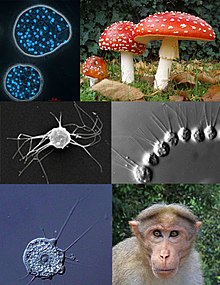Opisthokont
(Reguidit frae Opisthokonta)
The opisthokonts (Greek: ὀπίσθιος (opísthios) = "rear, posterior" + κοντός (kontós) = "pole" i.e. "flagellum") are a broad group o eukaryotes, includin baith the ainimal an fungus kingdoms,[5] thegither wi the eukaryotic microorganisms that are whiles grouped in the paraphyletic phylum Choanozoa (conventionally assigned tae the protist 'kinrick').[6]
| Opisthokont | |
|---|---|

| |
| Clockwise, frae top left: Abeoforma whisleri (Ichthyosporea); Amanita muscaria (Fungi); Desmarella moniliformis (Choanoflagellatea); Bonnet Macaque (Metazoa); Nuclearia thermophila (Nucleariida); Ministeria vibrans (Filozoa) | |
| Scientific classification | |
| (unranked): | Unikonta |
| (unranked): | Obazoa |
| (unranked): | Opisthokonta Copeland 1956,[2] emend. Cavalier-Smith 1987,[3] emend. Adl et al., 2005[4] |
| Subgroups | |
References
eedit- ↑ Loron, Corentin C.; François, Camille; Rainbird, Robert H.; Turner, Elizabeth C.; Borensztajn, Stephen; Javaux, Emmanuelle J. (22 Mey 2019). "Early fungi from the Proterozoic era in Arctic Canada". Nature. doi:10.1038/s41586-019-1217-0.
- ↑ Copeland, H. F. (1956). The Classification of Lower Organisms. Palo Alto: Pacific Books.
- ↑ Cavalier-Smith, T. (1987). "The origin of fungi and pseudofungi". In Rayner, Alan D. M. (ed.). Evolutionary biology of Fungi. Cambridge: Cambridge Univ. Press. pp. 339–353. ISBN 0-521-33050-5.
- ↑ Adl, S.M.; et al. (September–October 2005). "The new higher level classification of eukaryotes with emphasis on the taxonomy of protists". Journal of eukaryotic microbiology. 52: 399–451. doi:10.1111/j.1550-7408.2005.00053.x. PMID 16248873.
- ↑ Shalchian-Tabrizi K, Minge MA, Espelund M.; et al. (2008). Aramayo, Rodolfo (ed.). "Multigene phylogeny of choanozoa and the origin of animals". PLoS ONE. 3 (5): e2098. Bibcode:2008PLoSO...3.2098S. doi:10.1371/journal.pone.0002098. PMC 2346548. PMID 18461162. Explicit use of et al. in:
|author=(help)CS1 maint: multiple names: authors leet (link) - ↑ Steenkamp ET, Wright J, Baldauf SL (2006). "The protistan origins of animals and fungi". Mol. Biol. Evol. 23 (1): 93–106. doi:10.1093/molbev/msj011. PMID 16151185.CS1 maint: multiple names: authors leet (link)